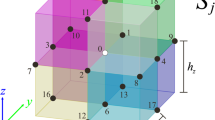Abstract
This paper investigates the influence of inhomogeneous head tissue conductivity on EEGs. A head model with inhomogeneity of radial and tangential conductivity is built up. Based on this model the EEG signals are calculated using the finite elements method. The results show that the inhomogeneous radial and tangential conductivity of skull tissue, which has been ignored so far, can cause about 5% difference compared with commonly used homogeneous conductivity head models.
Similar content being viewed by others
Reference
Peters, M. J. and de Munck, J.On the forward and inverse problem for EEG and MEG, in Auditory Evoked Magnetic Fields and Electric Potential, F. Grandiori, M. Hoke and G. L. Romani, Eds, Basel, Karger, Vol. 6, pp. 70–102, 1990.
Thevenet, M. et al,The finite element method for a realistic head model of electrical brain activities: Preliminary results, Clin. Physiol. Meas., Vol. 12, Suppl. A, pp. 89–94, 1991.
Haueisen, J. et al,Influence of tissue resistivities on neuromagnetic fields and electric potentials studied with a finite element model of the head, IEEE Trans. Biomed. Eng., Vol. 44, pp. 727–735, 1997.
Marin, G. et al,Influence of skull anisotropy for the forward and inverse problem in EEG: simulation studies using FEM on realistic head models, Human Brain Mapping, Vol. 6, pp. 250–269, 1998.
Witwer, J. G., Trezek, G. J. and Jewett, D. L.The effect of media inhomogeneities upon intracranial electrical fields, IEEE Trans. Biomed. Eng., Vol.19, pp. 352–362, 1972.
P. Wen, P. and Pope, K.The study of inhomogeneous human head models for EEG forward problem based on tissue conductivities, International conference on mathematics and engineering technology in medicine and biological science. Las Vegas, Nevada, USA, June 25–28, 2001, pp. 351-356.
Wen, P., He, F. and Sammut, K.The inhomogeneous conductivity property of cranial tissues and its representation in numerical head model, Australasian physical & engineering sciences in medicine, Vol.22, No. 3, pp. 92–98, 1999.
Meijs, J. W. H. et al,On the numerical accuracy of the boundary element method, IEEE Trans. Biomed. Eng., Vol. 36, No. 10, pp. 1038–1049, 1989.
Author information
Authors and Affiliations
Corresponding author
Rights and permissions
About this article
Cite this article
Wen, P. The impact of inhomogeneous tissue anisotropy on potential distribution within head model. Australas. Phys. Eng. Sci. Med. 26, 115–118 (2003). https://doi.org/10.1007/BF03178780
Received:
Accepted:
Issue Date:
DOI: https://doi.org/10.1007/BF03178780




